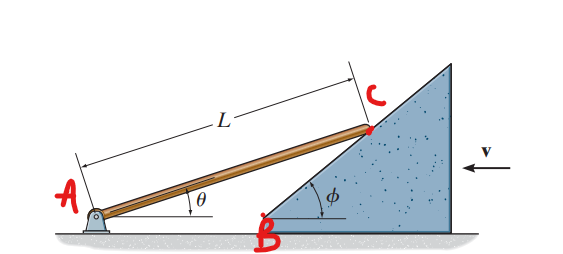There are many ways to solve this problem. Probably the easiest is to use absolute coordinates.
e.g. using the following points:

estimate the length between points AB and the length L. this can be done with the law of sines:
$$ \frac{x_{BA}}{\sin(\phi-\theta)} =\frac{L}{\sin (180^o -\phi)} $$
This can be written as:
$$ x_{BA} =\frac{L}{\sin (180^o -\phi)} \sin(\phi-\theta) $$
you can find the velocity by differntiating:
$$ \dot {x}_{BA} = - \frac{L}{\sin (180^o -\phi)} \cos(\phi-\theta) \dot{\theta} $$
However, because point B is moving with the wedge and point A is fixed:
$$ \dot {x}_{BA} = v \rightarrow v = - \frac{L \cos(\phi-\theta) }{\sin (180^o -\phi)} \dot{\theta} $$
The angular velocity for AC $\omega_{AC}$ is $\dot{\theta}$, therefore:
$$\omega_{AC} = \dot{\theta} = - \frac{\sin (180^o -\phi)}{L \cos(\phi-{\color{red}\theta}) } v $$
The negative sign, means that for negative velocity (point to the left) the angular velocity is positive.



